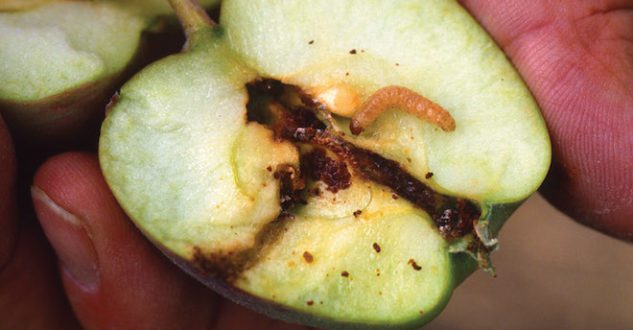Jan 29, 2022Free online summit tackles codling moth
A free virtual “Codling Moth (CM) Summit” will be held Feb. 24. The session will include a long-term look at the biology, control and treatment of CM.
The event is sponsored by Washington State University Extension, Oregon State University Extension, Northwest Horticultural Council, Washington Tree Fruit Research Commission and Wilbur-Ellis. It will feature recorded presentations and time for questions and answers.
The summit will be held from 11 a.m.-7:30 p.m. Register by Feb. 22 at https://www.eventbrite.com/e/codling-moth-summit-tickets-231248238707
For registration questions contact: WSU Extension – Email: [email protected]
Phone: 509-786-5609 or 509-788-5459.
The foundation
Knowing the fundamentals of codling moth biology, pheromone traps, and models is critical for implementing control tactics. The science must be understood to implement the practices and adjust controls.
- Biology and ecology: A presentation of codling moth history, host ranges, reproduction, and the influence of temperature on development.
- The decision triad:
- Predictive models: Models predict the expected development (phenology) of an insect, but do not always represent exact field populations. Interpretation of models will be discussed.
- Monitoring and identification: Trap placement, density and lure type are affected by the biology and dispersion of codling moth. Knowing how to interpret counts in relation to prior experience is key in pest management.
- Socioeconomic and orchard management:Orchard pest management, like pruning and thinning, is expensive and conducted on viable blocks. Abandoned or neglected orchards can lead directly to high populations of codling moth infesting neighboring blocks.
Control tactics
Successful integrated pest management (IPM) programs integrate four pillars of control tactics and are flexible enough to adjust for seasonal changes in pest and beneficial insect populations. The most stable IPM programs take a multi-tactic approach, utilizing as many pillars of control as possible. IPM programs that don’t follow this strategy lead to programs that become inherently variable in performance.
- Autocidal: Techniques that control insects by reducing their reproduction potential.
- Mating disruption:History to current practices. Essential to an IPM program is understanding the different pheromone release techniques and their unique strengths and weaknesses used in mating disruption.
- SIR: The tales of two countries– Sterile Insect Release (SIR) programs have been used successfully under an areawide concept in other countries with different models for deployment.
- Cultural control:Orchard sanitation and proper bin management are examples of direct pest removal while netting and bagging fruit are exclusion tactics. Practicing even one of them will help reduce codling moth populations.
- Chemical: The success of codling moth chemical control is dependent upon rotation of products to avoid pesticide resistance, optimization of sprayers and the planning of a robust spray program.
- Resistance management: Historically, the availability of different chemical choices has been driven by regulations and pesticide resistance. Understanding how the over use of chemical classes leads to the loss of products should be the foundation of a spray program
- How to build a spray program: Chemical choices are clear, but the challenge is how to build a spray program that incorporates “The Decision Triad” and takes advantage of the selectiveness (ovicides, larvicides) of new chemistries.
- Sprayers: Sprayer calibration and optimization per canopy architecture is achievable if it is prioritized by management and personnel understand the effect of air, nozzles and rates on deposition.
- The apex: IPM roof
- Codling moth control is perpetual to avoid crop loss and outbreaks. Area wide management with all IPM tactics is critical with this highly mobile, multi-generational pest.
– Washington State University Extension















